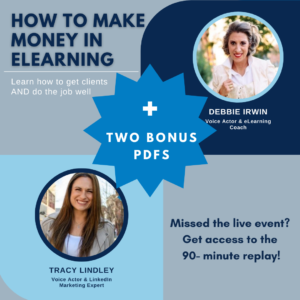Teaching voiceover artists and medical illustration artists. That’s how.
Through this month, a rather cold and unforgiving March, I’ve been working hard to influence and engage the next generation of voice actors and those in mid-career who seek to improve their craft. After coaching for several years now and seeing the results in the blossoming works of many of my earlier students, I continue teaching to help them:
- Avoid obstacles that made me stumble when I was new to voice acting.
- Develop nuanced vocal styles depending on the script, and
- Learn how to act like a professional. (Pun intended!)
Some of you reading this might have participated in my March lessons, but for those who weren’t, here’s a brief synopsis, and hopefully, next time, you’ll join me!
Checking in on Biomedical Visualizers
The first of the trio of talks I gave this month was to graduate students at the University of Illinois Chicago working hard towards their Masters’s degrees in Biomedical Visualization.
It was titled “What to Know About VO and Other Questions You Never Asked Yourself” and allowed them to
- Hear from a medical narration expert about the value of adding narration to their animations.
- Learn the importance of working with professional voice talent, and
- Understand how a creative partnership leads to a successful project outcome.
More than ever, effective scientific, medical, and healthcare communication is critical to reaching various audiences, including patients, healthcare professionals, physicians, researchers, and pharma companies. As these young professionals enter the workforce, they will take complex scientific ideas and simplify them visually for people to understand and retain. A professional voiceover narration plays a key role in that journey.

Think of an opera. It’s a big production and a long time in the making. The same is true for medical animations. From ideation to the science writers to the creative conceptualization of the project, to the medical illustration, animatic, scratch voiceover, composition of music or customization of canned music, and final animation with the final audio recording and final “mixing” of the project, different people show up on the stage at different times. The more each character understands the whole, the richer the outcome. I call this creative cross-pollination. Forging relationships and networking with each other brings greater opportunities for all– medical illustrators, medical animators, medical writers, musicians, and voice actors alike.
Anthem Reads and Explainer Videos: What Are They?
The second gathering of the month was with a group of voice actors interested in two of the most common types of jobs to land in their recording booths. Anthem reads are most often found in corporate videos, though some commercials also have an anthemic quality to them. (For example, the classic “Morning Again in America” spot for Ronal Reagan, the iconic “1984” Apple Superbowl spot, and many Nike spots, like “Greatness”.)
The first piece of the puzzle is easy– what do we know about this genre in particular? Scripts that are Anthemic are majestic pieces of poetic storytelling, rallying cries to motivate you to feel proud and inspired. They frequently include words like pioneer, champion, visionary, responsibility, sustainability, tradition, commitment, prosperity, collaboration, passion, history, evolution, global, and future. If you’d like to see my full list click here.
Explainer videos, instead, are casual and conversational rather than powerful. They are upbeat, engaging short stories that present a problem, the company’s solution, a ‘this is how it works’ explanation and a call to action at the end. They have a friendly narration style.
Here’s an example:
“Meet Jane. She works at ABC company and is overwhelmed with online voiceover casting sites and the hundreds of crappy auditions she gets. She has to stay late at the office just to listen and find a voice actor who’s better than average. It’s like looking for a needle in the haystack!” (Problem)
“When Jane found Blue Wave Voiceovers, she could easily pick from a diverse, professional boutique shop of voices that look and sound like American today.” (Solution)
“All she has to do is enter the type of voice she’s looking for, and a select group of top-tier talent is at her fingertips, waiting at their microphones to help get her project recorded and sent on its merry way. (How it works)
“So visit BlueWaveVoiceover.com to get the best talent for your project, and enjoy getting back to your friends and family in time for dinner! ” (Call to action or CTA).

Next comes the structure of the piece; a voice-over artist has to understand the genre to get the overall tone, but by deconstructing the script, one can understand how the piece was written; the nuts and bolts that hold it all together. Anthems, for instance, are often written with words that repeat. I call this the echo effect. Some ideas come in groups of three, some are interwoven with compare and contrast language, some are temporal, talking about a company’s history and the future, and sometimes data and statistics are used to drive home a point. Once you see the writer’s tactics, you get a better sense of their intentions for the story’s arc. It’s like a roadmap for the narrator.
Explainers are also written with structures, though they follow a more basic format. The language is simple; you’ll find words like simple, easy, just, only, any, and no problem and phrases like “you can even do this!” conveying the facility of the solution to the aggravating problem. Often times questions are posed, like “ Don’t want to download software or an app? No problem.” or “ Have your own question or something you’d like to share?
Finally, the content of the material needs to be understood! The content will inform who you are, who you’re talking to, and what’s important to learn so you can be sensitive to the needs of your listeners. Are they health care professionals (HCPs) who are helping a patient navigate health care insurance options before entering a cancer treatment program?
Are they elderly patients who need to hear (slowly and clearly) how to care for themselves after surgery? Are they caregivers who need to understand how to operate in-home medical devices?
By getting a handle on the genre, structure, and content you’ll have a strong, convincing narration ready for prime time.
Making Money In eLearning: The Steps to Success

The third of my webinars was again to a group of voice over artists. My colleague, friend, and LinkedIn expert, Tracy Lindley, partnered with me, and the event was a huge success. (You can still purchase the 105-minute replay by clicking here.) In this talk, Tracy focused on how to find eLearning clients using LinkedIn, and I spoke about the importance of acting like a professional, so you can win their trust.
Voice actors, no matter how passionate they are about their craft, don’t always understand the importance of the work outside the recording booth. There are many ways to show professionalism, and my goal is to help people be top-notch throughout the sales process.
And yes, it is a sales process before, during, and after the voiceover project has been completed.
Making money in eLearning or medical narration, which is my expertise, can be difficult because it ultimately relies on your ability to convince buyers that you can deliver clean, error-free audio quickly and on time. Obviously, you also have to have talent, or else an AI will surely take your place. Luckily, if you develop key skills (both soft and hard) and have a communication plan, you can succeed. Follow along, and you’ll be a pro in no time.
- Engage. Ask questions.
- Show them your workflow.
- Confirm you understand the scope of the project. Document the details.
- Pre-Prep. Comb the script and gather specific questions.
- Prep. Ask yourself questions like who’s the audience? Who are you? How should this script be delivered?
- Perform. Get in the tone zone. Be considerate of your listeners.
- Edit. Editing takes four times as long as recording.
- Deliver on time or early. Ask for feedback.
- Invoice your client.
- Stay in touch. Trust and confidence are founded on professionalism.
As long as you communicate well and deliver quality work, you’ll have no problems earning money in your voiceover career. In fact, you don’t have to be the most talented voice actor to succeed, but if you’re sloppy, lazy, slow, don’t take directions well, and/or a poor communicator, you surely won’t. If you want to l(earn) even more, this blog might not be enough. Sign up on my website to be notified of upcoming classes!!